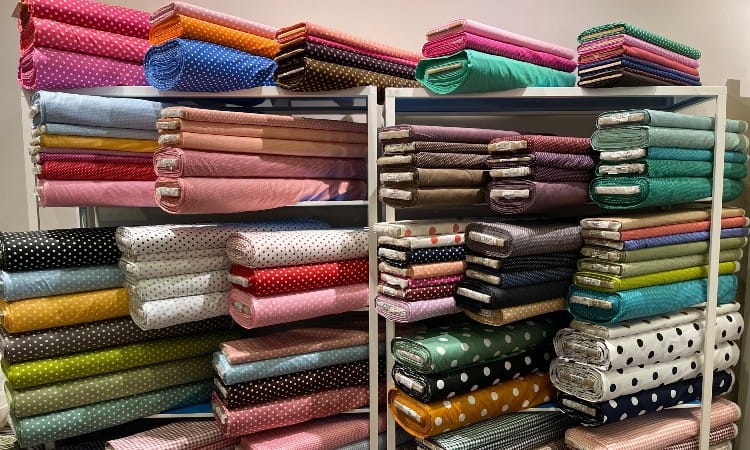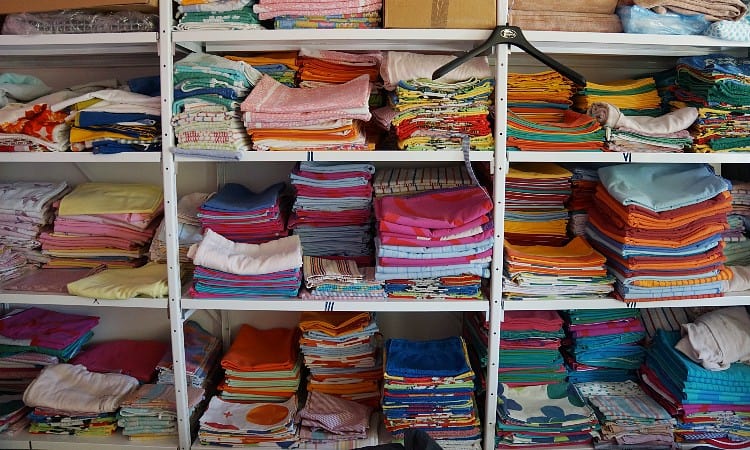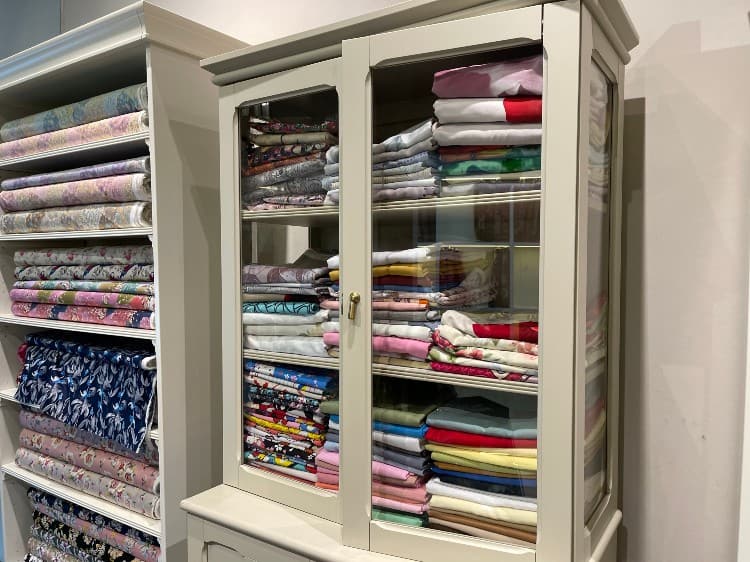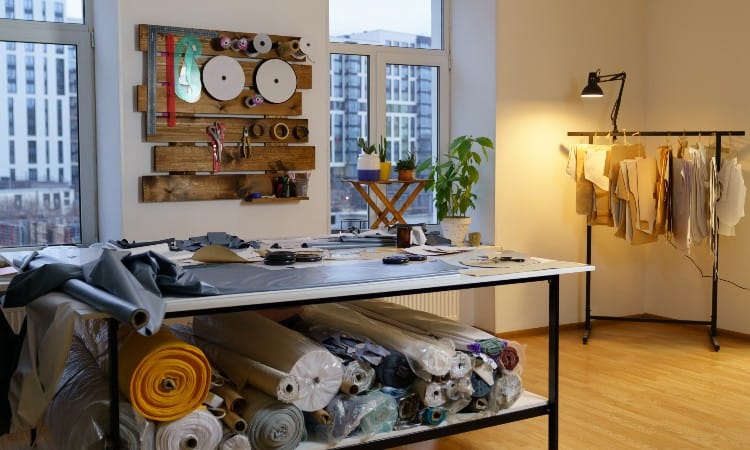Sewing is one of my favorite hobbies, and I’m always looking for a new project to make for myself or my family. Over time, however, my sewing room has been overrun with all the different fabric types I keep on hand to work with. Because of this, I’ve spent a lot of time working on finding the perfect solution for how to store fabric in my home.
The key to storing fabric is to create an organizational system and stick to it. Your system will work best if it is easy for you to access as you sew without disrupting your workflow. You’ll also need to make sure that you take steps to keep your fabric away from pests, pet hair, moisture, or light.
I’ve used many different techniques for storing my fabrics over the years, and I can’t wait to share some of them with you. In this article, you will learn different ways to organize and store your fabrics and some important tips to keep in mind to keep your fabrics looking their best.

Quick Navigation
- Why is it Important to Store Fabric Correctly?
- How to Store Fabric: 3 Tips
- What Are the Best Places to Store Fabric?
- How to Fold Fabric for Storage
- How Do You Store Fabric on a Shelf?
- Is it OK to Store Fabric in Plastic Containers?
- How to Store Fabric Rolls
- How to Store Bolts of Fabric
- Fabric Storage Ideas for Small Spaces
- What Is the Best Way to Store Fabric?
Why is it Important to Store Fabric Correctly?
It is very important that you store your fabric correctly for your own peace of mind and to help keep your fabrics looking and feeling their best over time. For starters, a well-organized fabric stash will be easy to use and you’ll always know what fabrics you have on hand. This means no more scrambling to find a piece of fabric, forgetting what you have, and buying new fabric you don’t need.
How you store your fabrics also affects how well they hold up over time. Many things can damage fabric, including sunlight, moisture, and pests. A good storage system will help keep these things away from your materials, reducing the chance that they could be ruined before you use them.
How to Store Fabric: 3 Tips
When it comes to fabric, one of your priorities should be storing it in a way that helps keep the material from being damaged. In particular, you’ll want to take steps to prevent wrinkles, avoid moisture or sunlight, and keep pests away.
1. Try to Prevent Wrinkles
Storing fabric incorrectly can cause it to bunch up and wrinkle. At the very least, the wrinkled fabric will require you to spend extra time and effort ironing it to make it smooth before you cut and sew with it. At worst, you might be dealing with a fabric that cannot be ironed and which you will have to wash or dry clean to get the wrinkles out.
You can avoid all of this trouble by taking steps to store your fabric neatly. Laying the fabric flat or hanging it in your closet can help keep the fabric’s fibers straight, working to stop wrinkles from forming altogether. It takes a little effort upfront to arrange your materials but will save you time in the long run while keeping your fabric looking its best.
2. Avoid Moisture and Light
Moisture and light are both the enemy of fabric since both can cause damage to your materials that cannot be repaired. Moisture can lead to mold and mildew, which ruin the fabric and harm anyone who breathes them in. These things can also produce an odor nearly impossible to remove from the material.
Moisture can also damage the fabric by causing dyes to bleed or lose intensity. It can also lead certain fabrics to shrink or distort shape, ruining their overall look and feel. All-in-all, moisture is something you should avoid at all costs when storing your fabric.
Sunlight can also cause damage in its own right. Too much sun can cause fabric dyes to fade, which can never be undone. It can also cause fabrics to become brittle over time as the fibers heat due to constant sun exposure.
The best way to avoid moisture and sunlight is by storing your fabrics in airtight containers. Before doing this, you should ensure that your fabrics are completely dry, or else you could accidentally trap in any lingering moisture. If you don’t have containers on hand, try storing your fabric on a high shelf away from any windows to minimize the chance that water or light can reach your materials.
You can prevent mold and mildew by keeping your fabrics in a room with consistent temperature and low humidity. Storing your fabric in an attic, basement, or outdoor storage shed is not recommended if you’re trying to keep moisture and humidity away.
3. Keep Pests Away
Many pests like to make their home in fabric and can cause a lot of damage that may be impossible to repair. Fabric pests can feed on the fibers of your materials, creating holes or thinning the fabric over time. The most common of these pests are moths and carpet beetles, both of which are found all across the world.
Storing your fabric in airtight containers is one of the best ways to keep pests away from your materials. These insects won’t be able to get through the container to reach the fabric, meaning that they won’t ever have a chance to cause damage. There are also many types of pest control traps that can be purchased and placed alongside your fabric to hopefully lure these pests away from your materials.
What Are the Best Places to Store Fabric?
Many different places will work well for storing your fabric. Which works for you will depend on how much space you have, how much fabric you need to store, and your personal preferences.
1. Storage Shelving

Storage shelving is one of my go-to picks for storing fabric well. Shelves help keep fabric up off the floor and can hold a lot of fabric in a small space. All you need is an open stretch of walls to install your shelves.
The best way to use storage shelves is to neatly fold your fabrics to be roughly the same size, then stack them on top of each other. You’ll want to make sure you can see each fabric in the stack so that you know exactly what fabrics you have on hand at any time. This storage method is one of the simplest and often involves the least amount of work and doesn’t necessarily require you to purchase a bunch of materials to complete.
If you prefer the look of storage containers, you can also try putting your fabrics in decorative bins on top of your shelves. Just be sure to fold your fabrics so that the length of the folded materials is smaller than the width of your storage bin. This will let you store your fabrics with the folded edge facing upward so that you can see what you have to work with.
2. Containers With Lids
 One of the best ways to store fabric is in plastic tubs with airtight lids, especially if you choose clear containers that allow you to see what is stored in them. These totes’ lids can help keep pests or pet hair off your fabrics. They may also help to stop sunlight from fading your fabrics over time.
One of the best ways to store fabric is in plastic tubs with airtight lids, especially if you choose clear containers that allow you to see what is stored in them. These totes’ lids can help keep pests or pet hair off your fabrics. They may also help to stop sunlight from fading your fabrics over time.
The important thing to remember with storage containers is that they can get messy if you don’t keep them organized. Fold your fabrics and stack them with the edges facing outward so you can see what materials you have on hand. You don’t want to just throw your fabrics into the container or you will have to dig through the bins any time you want to find a particular fabric.
I use plastic containers stacked on top of one another to maximize the space in my craft room. I even stack some containers in the closet to free up extra space in my sewing area. I recommend using a container for each type of fabric you own, then organizing them within the container by color or by the pattern of the fabric.
3. Filing Cabinet

If you’re looking for a solution for storing smaller pieces of fabric, a filing cabinet might be a perfect choice! Many crafters store their fabric remnants in individual file folders, which they label and place inside a filing cabinet. This is also a great way to store fabric patterns and pattern pieces.
It’s important to note that this might not always work well if you’re trying to store large pieces of fabric. While not impossible, simple file folders won’t hold larger pieces easily and you’ll probably be better off choosing one of the other storage options we’ve discussed for these materials.
4. Fabric Hangers
 If you’re fortunate enough to have extra closet space to store your fabrics in, hangers can be an excellent way to keep your materials neat and organized! You can purchase hangers that are specifically designed for storing fabric or blankets. However, I find ordinary pants hangers are just as easy to use and are much easier to come by.
If you’re fortunate enough to have extra closet space to store your fabrics in, hangers can be an excellent way to keep your materials neat and organized! You can purchase hangers that are specifically designed for storing fabric or blankets. However, I find ordinary pants hangers are just as easy to use and are much easier to come by.
Fabric hangers will often have 4-5 bars that you can drape fabric over as they hangs in your closet. This lets you store lots of fabric in a small space. If you use individual pants hangers, you’ll likely only be able to hang one piece of fabric per hanger but can still store a few remnants in the back of your closet.
This method of storing fabric helps to keep it neat, wrinkle-free, and out of sight. If you have pets, hanging your fabric in a closet is a great way to keep unwanted pet hair off of your materials as well. You can even use the clamps on pants hangers to store other sewing supplies, like fabric cutting mats or pattern pieces.
5. Organizer Boards
 Another great way to store fabric is to wrap individual fabric pieces around organizer boards. Picture how fabric bolts are organized in your local craft store, where each fabric is typically wrapped around a rectangle-shaped piece of cardboard. The idea behind fabric organizer boards is essentially the same.
Another great way to store fabric is to wrap individual fabric pieces around organizer boards. Picture how fabric bolts are organized in your local craft store, where each fabric is typically wrapped around a rectangle-shaped piece of cardboard. The idea behind fabric organizer boards is essentially the same.
You can purchase fabric organizer boards online or make your own out of sturdy cardboard. Just make sure to cut evenly sized pieces of cardboard to wrap your fabric around. Then, store your fabric by standing the boards upright on a shelf or storage container.
Storage boards are one of the best ways to keep your fabrics neat and wrinkle-free. This is because these boards don’t typically require you to make many folds in your fabric. They’re also great at keeping the fabric’s fibers taut as they are wrapped around the board.
How to Fold Fabric for Storage
The key to organizing your fabric on shelves is to fold each piece into equal-sized squares or rectangles before you stack them. I prefer to fold my fabric into rectangles, roughly 6” by 9” in size. However, you can fold your fabrics to any size you want as long as they are consistent and fit on your shelf.
Start by laying your fabric pieces out flat so you can see the overall shape of the piece you are working with. Uncut fabric is easiest to fold, but you can fold irregular shapes with practice. Try to find the straightest edge and fold it over to meet the other edge of the fabric.
If necessary, you can create a straight edge by folding over the raw edge of the fabric towards the center until it is straight. This can make it easier to line the corners of the fabric up with one another. Then, continue to fold the fabric until it reaches your desired size.
Don’t be afraid to create a cardboard or paper template to work off of if you need some extra help keeping your folded fabric pieces consistent in size.
How Do You Store Fabric on a Shelf?
Once you’ve folded the fabric, you should stack it on your shelves with one of the folded edges facing outwards. This helps keep the shelf looking neat since it keeps the cut edges of the fabric hidden towards the back of the shelf. You’ll also be able to see what materials you have on hand since each fabric will be visible in your stack.
By only having the fold facing outwards, you also limit how much of your fabric is exposed to sunlight which further helps to stop it from fading. Similarly, folding the fabric and laying it flat can help to keep wrinkling to a minimum.
I organize my shelves by fabric type first, then arrange them by color. For example, I will take all of my 100% woven cotton quilting fabrics and stack them together. Within that stack, I’ll arrange the fabrics like a rainbow – red fabrics together, followed by orange, yellow, and all the other colors.
Is it OK to Store Fabric in Plastic Containers?
Plastic containers are a great way to store fabric, especially with a lid. Plastic containers’ lids can help keep moisture, pests, and sunlight away from your fabrics, keeping them protected.
You’ll just need to organize your fabrics well in the containers. The last thing you’ll want to do is dig through the bin to find what you’re looking for whenever you need a piece of fabric to work with.
How to Store Fabric Rolls

Fabric rolls can be a bit awkward to store because they are long and narrow. One of the best ways to store fabric rolls is to stand them upright in a bin or basket. You can stack several fabric rolls together without taking up too much floor space in your craft area.
If you don’t have a bin that will work to keep the rolls upright, you could also look into storing them horizontally on your walls. Head to your local hardware store and see if you can find large hooks and curtain rods that stick out far enough from the wall to hold the fabric roll. By doing this, your rolls will stay out of your way up on the walls and you can simply roll out as much fabric as you need for whatever project you are working on.
How to Store Bolts of Fabric
When storing entire bolts of fabric, take inspiration from your local craft store. Bolts work best when stored upright on a shelf side-by-side with the other bolts in your collection. This allows you to see what fabrics you have on hand while reducing how much space they take up.
If you don’t have the space to store your bolts upright, you can stack them on top of each other on a shelf with the long side of the bolt facing outwards. This will still keep the bolts neat and visible as you work.
Just be sure that you don’t keep your bolts on the floor. Keeping fabric of any kind on the floor of your craft room will only invite pests or moisture to enter your fabrics and ruin them. Bolts need to be stored up high on a shelf or in a container.
Fabric Storage Ideas for Small Spaces
When storing fabric in small spaces, cabinets and containers can take up more room than you have. For smaller areas, try to store your fabric vertically to use the room’s height. Storage shelves going up the length of the wall is one of the best ways to do this, as is hanging the fabric in an available closet.
If you plan to store the fabric long-term, consider using space-saving storage bags to reduce the overall bulk of your material. I’ll often take my seasonal fabrics that I won’t use again until the following year and place them into vacuum-seal bags to make them much smaller. I’ll store these bags in a closet or under-the-bed container to keep them out of the way until I need them next year.
What Is the Best Way to Store Fabric?
The best way to store fabric depends on your needs and the space you have on hand. Often, the simplest ways are the easiest and should be where you start. Try folding your fabrics and storing them on a convenient shelf or in a container you have on hand. If this system doesn’t work for you, you can consider moving on to one of the other solutions discussed in this article.